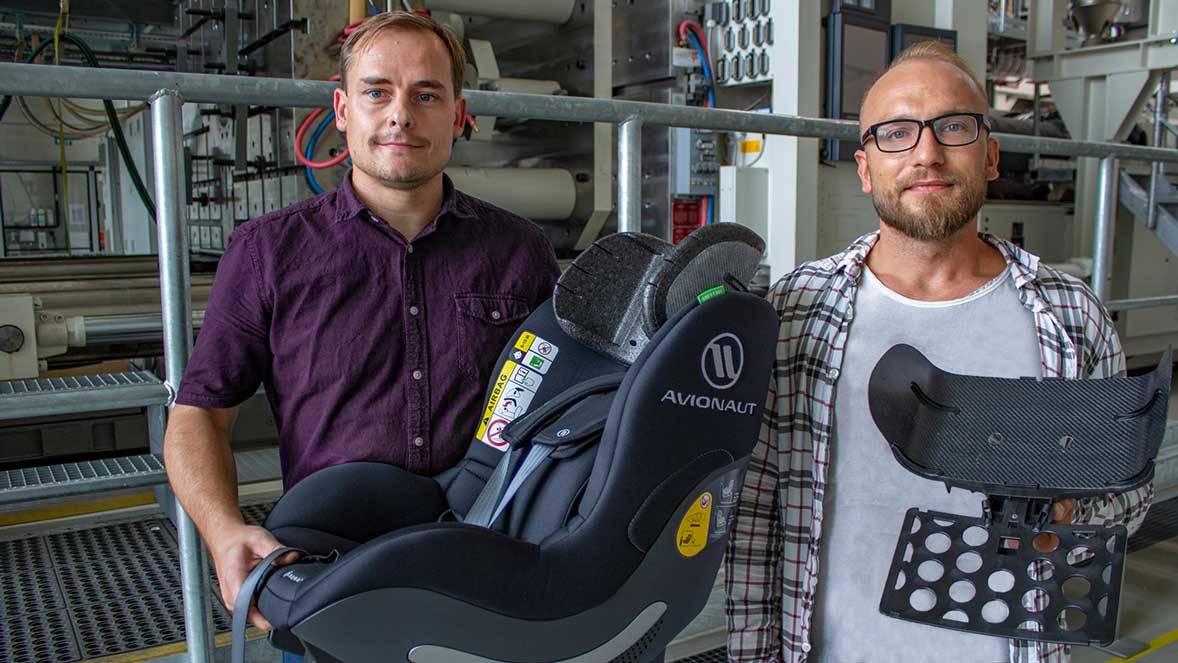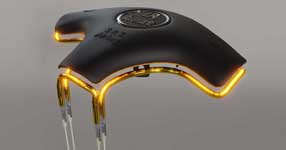Lightweight headrest with organic sheet for the child car seat
- Details
- Hits: 5716
A 26% lighter one headrest for Child seat Scientists have the TU Chemnitz Developed together with Avionaut and Polycomb. In addition, they have developed the technical basics to manufacture the headrest in a way that conserves resources.

The child seat in the car should be special three criteria meet: high security, low weight and easy to use. Researchers at the Professorship for Lightweight Structures and Plastics Processing SLK of the Technical University of Chemnitz have taken on these three points. Together with the Thuringian plastics company Polycomb and the Polish child seat manufacturer Avionaut, they designed an ultra-light headrest in a research collaboration. This also offers better crash performance and has been optimized with regard to component production.
Organic sheet reinforces the headrest
As part of the basic investigation, a shaped organic sheet was developed to locally stiffen the headrests. “Organic sheets are fiber fabrics that are enclosed in a plastic matrix. They are characterized by their particular rigidity, strength and low weight. They are therefore very suitable for lightweight construction as in Automobile- or aircraft construction ”, explained Norbert Schramm, Research Associate at the SLK Professorship.
Polycomb was responsible for injection molding in the further development. This is where the preform, i.e. the blank of the component being manufactured, was manufactured. This also includes the support plate for the headrests, which is used for integration into the back of the seat.
 Tracking system for child seats based on RFID and TBEN-S
Tracking system for child seats based on RFID and TBEN-S
Airplane gave the suitable ones as client Materials and realized the foaming of the headrest. It was done with foam beads made of thermoplastic Plastics thanks to the energy-saving particle-foam composite injection molding. In addition, one took over the completion of a demonstrator here.
The new headrest from the child's car seat Weight class from 9 to 36 kg is now 26% lighter than a comparable standard component. The technology development was funded by the Working Group of Industrial Research Associations (AiF) and the Federal Ministry for Economic Affairs and Energy (BMWi) as part of the Central Innovation Program for SMEs (ZIM).
Particle foam composite injection molding
In particle foam composite injection molding PSVG it is a coupled process. First, an insert made from an organic sheet is formed in an injection molding tool with a turning plate and back-injected with a short-glass reinforced plastic matrix. The resulting preform is then turned into a second tool on the machine and foamed over.
 Servo-electric hot runner systems for ultra-light central armrests
Servo-electric hot runner systems for ultra-light central armrests
Because there is no need for intermediate storage, cooling or reheating, this manufacturing process is special ressourcenschonend. The thermal energy introduced in the first step can be used further in the second step. The basic idea of bivalent resource efficiency has been applied here. It corresponds to the mission statement of the Merge Excellence Cluster at Chemnitz University of Technology. Merge has set itself the goal of saving energy in use and production. The additional savings in the manufacturing process are achieved by removing the component from the ready-to-install Tools comes.
Transfer of the headrest to production
The transfer of the manufacturing process of headrests for children’s car seats in one step and the component design offer several advantages for manufacturers and users. Assembly steps and energy in production can be saved with PSVG. The components of the end product hold together better. The significantly reduced weight leads to further Energy savings while transporting. Handling when installing and removing the child seat is made easier.
 Infrared heater for efficient heat processes in industry
Infrared heater for efficient heat processes in industry
Financial savings gained from the economy of the headrest can be passed on to the consumer. The transfer of the results of the research project for the production of the ultra-light headrest into practice is now the responsibility of the child car seat manufacturer.
